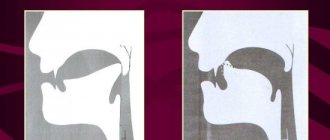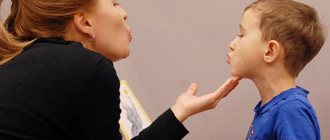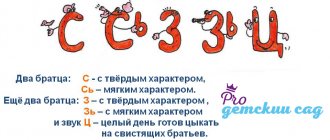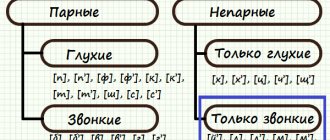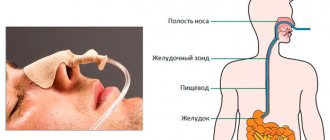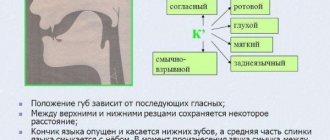Pronunciation of the T sound
We can highlight common mistakes made in the pronunciation of the T sound:
- replacing the sound T (it is front-lingual) with G and K (they are called back-lingual);
- mixing or rearranging consonants located next to the sound T (“rolled” instead of “glass”);
- after P or K, the T sound is lost and replaced with a softening (“piichka” instead of “birdie”);
- replacing the sounds Ch and C with T (“nine” instead of “girl”, “Petsya” instead of “Petya”).
Children who replace the T sound with some other sound often have incorrect articulation. The child raises his tongue to the palate, while the tip of the tongue should rest against the front teeth.
The reasons for incorrect pronunciation are as follows:
- malfunctions of the articulatory apparatus (speech organs);
- the lower jaw is weakly developed, which is why it is inactive during speech;
- the hearing organs are poorly developed, which is why the child cannot distinguish sounds by ear;
- imitating an adult who has problems with correct pronunciation.
Only a speech therapist can make a diagnosis. And parents, in turn, can practice at home the exercises recommended by a professional.
Correction
Speech therapy correction
Phonemic disorders that occur in children with physiological dyslalia do not require speech therapy intervention. Correction of pronunciation errors caused by other speech disorders is carried out in the following areas:
- clarification of the articulation of replaced sounds and substitute sounds;
- development of phonemic awareness;
- formation of skills in sound analysis and synthesis;
- development of differentiated perception of speech sounds.
Methods of speech therapy include articulation gymnastics, finger gymnastics, and logomassage. In case of severe pathologies of speech, affecting not only the sound side, but also its other components, work is carried out on all disturbed processes: prosody, voice, vocabulary, grammar, vocabulary, understanding of speech in general.
Medical events
Correction of malocclusion can be carried out using various methods. It depends on the type of disorder, age, and severity of the problem. In preschool age, functional orthodontic appliances and myogymnastics are widely used. In case of permanent occlusion, treatment is carried out with the help of braces, aligners, and, if necessary, orthognathic operations are performed.
Rehabilitation of people with hearing loss is carried out through hearing aids. After selecting and adjusting a hearing aid, such children need classes with a teacher of the deaf and a speech therapist.
Articulatory gymnastics for the sound t
It is necessary to do articulation exercises daily. Get used to the fact that in any free time you and your baby develop the speech apparatus.
More on the topic:
- Articulatory gymnastics for the sound Ш
- Exercises for sounds “S, C, Z”
Setting the T sound
- Choose several syllables or words that contain the letter combination TA, and repeat them at least 10 times.
- Place the tongue between the teeth and press it firmly, but at the same time so that it does not hurt the baby, with the jaw. Take a deep breath and, as you exhale, say an interdental T.
- Place your tongue between your teeth again. Stretch your teeth in a smile and “spit.” After this, give your jaw a rest.
- T is a derivative sound from P. Therefore, you can start warming up by practicing the sound P. Say Pa-Pa several times, while the wide part of the tongue should be pressed to the lower lip. Gradually stretch your lips into a smile and move on to pronouncing Ta-Ta.
- Place the tongue between the teeth. Say Pa-Pa again several times. At this moment, the adult spreads the child’s lips with his index finger and thumb. When the manipulation is performed correctly, Ta-Ta is pronounced.
Didactic games in speech therapy for preschoolers
Sound production
- Talk to the child Ta-Ta.
- A special paddle is used to soften the sound. Use it to press the tip of your tongue and lower it down. You should get the letter combination Tya.
- The sound Th is produced by clicking the tip of the tongue; the teeth should be closed at this time.
- You can complicate the exercise: do not press your tongue against the palate, but stick it out.
Do I need to contact a specialist?
If the sound “k” cannot be pronounced correctly by a child aged 4-5 years, then parents can try to teach how to pronounce it by organizing classes at home. It is very important to conduct them in a playful way. The child should be interested. You cannot force him, otherwise he will lose the desire to learn.
At the initial stage, classes are conducted by parents no more than 4-5 times a week for 10-15 minutes, then the frequency and duration of special exercises can be increased.
You need to practice in a convenient place, in front of a mirror, so that the baby can see the movements of his lips and have the opportunity to observe the facial expressions of mom or dad. The child should be praised for any success in pronouncing sounds.
If a problem with the pronunciation of the letter “k” is discovered in a child later, for example, at the age of 6-7 years, then he should be taken for a consultation with a speech therapist. A specialist will help you learn how to pronounce it as soon as possible so that the child does not have problems when studying at school.
You should also contact a speech therapist if classes are held for a long time, but do not bring results, the child cannot master the pronunciation of sounds. A professional will quickly find the reason why he cannot pronounce the sound “k” and give recommendations on how to eliminate it.
Speech therapy exercises
It is necessary to work on overall articulation and clarity of speech. For this, simple and interesting speech therapy complexes are used. We present one of these to your attention.
- “Brushing our teeth.” Stretch your lips in a smile, mouth slightly open. Use your tongue to walk alternately over the upper and lower teeth from the back side. Move from left to right and then in the opposite direction.
- "Spatula". Smile again with your mouth slightly open. Place the wide part of your tongue on your lower lip. Stay in this position for 10 seconds. You can start with 5 seconds.
- “Tube”. Extend your tongue as much as possible and tense it. Then, if possible, roll it up into a tube and stay in this position for 5-10 seconds.
- "Swing". Open your mouth slightly and press the wide part of your tongue against your lower teeth. Then raise your tongue to your upper teeth. We linger in each position for 2-3 seconds. In this case, you need to press with maximum force.
- "Slide". Starting position – mouth slightly open. Press the tip of your tongue firmly against the bottom row of teeth. Then, without lifting the tip, press with the wide part of your tongue (it should bend as if). Stay in this position for 5 seconds.
- "Mountain Wind" Place your tongue in the position described in the previous exercise and blow as hard as possible. In this case, the entire speech apparatus should be tense.
How to teach a child to say the letter “K”?
If you decide to study with your child at home, then parents should master the methods of pronouncing the sound “k”, make a selection of special speech therapy games and exercises that will help teach him to pronounce this letter.
Before conducting classes teaching your child correct literary pronunciation (spelling), you should perform several general speech therapy exercises to warm up the speech apparatus. The most effective are:
- "Tube". The child should extend his lips forward with a tube and hold in this position for 5 seconds.
- "Smile". The baby should be asked to smile as wide as possible, but not show his teeth.
- "Snake". The child should be asked to stick his tongue out and in between tightly compressed lips 5 to 7 times.
- "Fence". The son or daughter should smile, showing the lower and upper teeth.
- “Brushing our teeth.” The child opens his mouth as wide as possible and runs his tongue along the inside of the upper teeth, then the lower ones, first from left to right, and then vice versa.
Articulation gymnastics is carried out for 10 minutes. With its help, you can prepare the speaking muscles of the face to perform games and exercises aimed at mastering the sound “k”.
Methods for making the sound “k”
The sound “k” belongs to the group of back-lingual sounds. To pronounce it, you need a high rise at the root of the tongue. Children often skip these sounds or replace them with easier-to-pronounce front-lingual ones. If we exclude pathologies due to which the baby cannot pronounce the letter “k,” then we can say that the child’s tongue is lazy to work at full capacity.
If the child is unable to speak the letter “k”, the child replaces it with the letter “t” (“tofta” instead of “jacket”, “tapitan” instead of “captain”, “Tatya” instead of “Katya”, etc.). In some situations, it is enough for parents to clearly pronounce the sound a couple of times so that the child sees their facial expressions and can repeat it. But not all children immediately grasp the correct pronunciation.
One of the methods for teaching how to pronounce the letter “k” is a mechanical technique. The parent invites the son or daughter to pronounce the syllables “ta-ta-ta” several times. While he does this, mom or dad presses the tip of the tongue down and moves it slightly back. You can perform the manipulation using your finger or the handle of a teaspoon.
The tongue moves back, presses against the palate, and gradually takes the position necessary for a clear pronunciation of the sound “k”. It is enough to repeat the technique several times, then the baby begins to pronounce the letter without outside help.
Consolidating the sound “k” in a child’s speech
After the baby learns to pronounce the letter “k” on his own, parents should pronounce with him every day as many words as possible in which it is used. Tongue twisters (“The pussy has soft paws”, “We bought a cuckoo hood”, “Dwarf Karl was tumbling on the carpet”, “Klava put a bow on the shelf”, etc.), proverbs or poems are also suitable for this purpose.
Games and exercises
To teach your child to pronounce the letter “k”, you should do the following exercises with him:
- "Slide downhill." The child is taught to hold his tongue in a slide position. Then a cotton ball is placed on his palm. Next, the baby should keep the root of the tongue slightly raised, while lowering its tip. After completing the steps described above, the child should exhale air, blowing the ball off his palm. When performing this exercise, the sound “k” should be heard. Not all children are able to pronounce it the first time.
- "The language is a fighter." One of the parents and son or daughter sit in front of the mirror. The child should be told that his tongue turns into a fighter who will have to fight with an enemy (mom or dad's index finger). The baby begins to smile with his mouth open as wide as possible, and at this time the adult rests his finger on the tip of his tongue, pushing it back a little. The child tries to push the finger out of the mouth. The parent finger then moves to the front wall of the tongue, pressing lightly on it. Eventually, the baby's tongue will take the "slide" position necessary for the correct pronunciation of the "k" sound. Next, the child will be able to put his tongue in the correct position without struggling with the adult’s finger. When performing this exercise, parents should be extremely careful not to scratch the baby's mouth with their nails or cause a gag reflex. Hands must be washed clean.
5 recommendations for parents
Conducting speech classes gives results, but in addition to them, parents should play games with their baby that promote the development of fine motor skills.
Why do you need to develop fine motor skills and what are the benefits of it? This article will tell you.
Mom or dad can sort through cereals or pasta with him, teach the child to string beads on a thread or fishing line, and sculpt figures from plasticine or salt dough.
- Speech therapists and speech pathologists also recommend that parents:
- Ask the baby to repeat the sound if he pronounced it successfully.
- When a child has learned to say a letter, its pronunciation is reinforced by pronouncing phrases, syllables and words with it.
- Mom or dad can invite the child to remember words with the sound “k” on his own, name pictures from a book where it is present.
- A child should not be forced to study if he does not want to or does not feel well.
- If there is no result from studying at home, the child is shown to a speech therapist or defectologist.
Setting the sound t when replacing with k
- First you need to teach your baby to distinguish between these two sounds. To do this, you can give pictures, the images in which begin with the sounds T or K, and also pronounce such words out loud. Ask the child to distribute into groups (K and T).
- Game “Catch the Sound”. The adult pronounces a small series of letter combinations, and the child must clap his hands when he hears the given sound.
- We are looking for the sound K. Dar-ra-ko-so. Sa-lo-ku-we. Am-da-ka-he ku-ro-lo-ky
- We are looking for the sound T. Ba-ta-do. Na-la-to. Ash-bo-ot. Ju-fu-fu.
Speech development in older preschoolers through play activities
Why can't my child pronounce the letter "k"?
A common reason that a child does not say the letter “k” is that parents and other close relatives coo with him, that is, they imitate his undeveloped speech skills. An adult's speech drops to the level of a child's speech. A child, without hearing normally pronounced sounds and letters around him, cannot learn how to pronounce them correctly. In order for the baby to learn to speak correctly, the parents’ speech must be clear and understandable.
Other reasons that prevent a child from correctly pronouncing a particular sound, in particular “k,” are as follows:
- Pathologies of the hearing aid or visual organs.
- Too big or small tongue.
- A short ligament located under the tongue.
- Paresis of the root of the tongue.
- Thin or thick lips that interfere with normal articulation.
- Irregular structure of teeth or jaw.
- Hypotonicity of the root of the tongue.
- Rhinolalia (splitting of the hard and soft palate).
- Gothic, slit-like or narrow structure of the palate.
Setting the t sound for dysarthria
At the very beginning, you need to pay attention to warming up the tongue and removing tone, as well as general gymnastics for the speech apparatus. For this purpose, the speech therapy exercises listed above are used.
- Raise and lower your tongue, turn right and left. In this case, the tongue is extended as much as possible.
- Then the adult invites the child to tap his tongue on the upper palate (the sound should be T).
- To obtain a soft consonant, the tongue is pressed harder against the palate and moves out more between the teeth. At the same time, the passage for air is reduced.
- To practice the T sound, it is pronounced between two vowels (at least 10 repetitions).
- The baby must cluck at least 20 times. After this, the task becomes more complicated: you need to click while exhaling, not while inhaling.
- The child is asked to place his palm on his larynx. After this, pronounce the sounds T and D. Focus on the difference in vibrations during the pronunciation of the sounds T and D.
violation of sound pronunciation with normal hearing and intact innervation of the speech apparatus.) The child either cannot pronounce the sound (misses it or distorts the pronunciation), or boldly replaces one sound with another.
Dyslalia can be simple
(one sound or a group of similar pronunciation sounds is defective (for example, whistling s, z, ts) and
complex
(the pronunciation of sounds of different groups is impaired (for example, whistling and hissing sh, sh, zh).
Very often, parents turn to a speech therapist with the request: “Take a look at the child because he does not pronounce the sound “R.” When the speech therapist begins to examine him, it turns out that his pronunciation of a number of sounds is impaired.
Most often defective are the hissing sounds sh, zh, ch, shch,
sibilants -
s, s, z, ts,
sonoras -
r, r, l, l
.
k, k, g, g, x, x, d, d, t, t, y, v, f
are disturbed less often If a child cannot pronounce the sound Ш clearly,
then the pronunciation of the sounds
zh, ch, shch
also suffers. Usually the entire group of sounds is disrupted.
It is too early to make lame sounds before the age of three , but it is necessary to prepare the child and his articulatory apparatus for correct pronunciation and speech. Speech therapy massage can and should be used in children from 2 months, and speech therapy gymnastics - from two years.
PHYSIOLOGICAL DYSLALIA
- a disorder of sound pronunciation, observed in children under the age of 5 years and caused by insufficient development of movements of the organs of articulation, as well as insufficient development of phonemic hearing. Physiological dyslalia is otherwise called age-related sound pronunciation disorder.
The speech of young children during the period of its formation is always characterized by shortcomings in sound pronunciation. This is caused, first of all, by the insufficient development of movements of the organs of the articulatory apparatus: tongue, lips, soft palate, lower jaw. Another reason is insufficient development of speech (phonemic) hearing. Therefore, at the beginning and during preschool age (3-5 years), speech is not yet clear enough and pure in sound.
The most typical age-related imperfections in sound pronunciation:
•· Consonant sounds are pronounced softer: “lampa” instead of “lamp”, “miska” instead of “bear”, “zyuby” instead of “teeth”;
•· Hissing phonemes will be replaced by whistling ones: “elk” instead of “spoon”, “syapka” instead of “hat”, “mesh” instead of “brush”;
•· They do not pronounce the sound “r” at all or replace it with the sounds “l, l, v, th”: “lyba” instead of “fish”, “leza” instead of “rose”, “kavman” instead of “pocket”, “yak” instead of "cancer";
•· The sound “l” is most often absent ( ampa
, instead of
lamp
), is softened or replaced with "th": "luk" instead of "bow", "yampa" instead of "lamp";
•· The sounds “k, g, x” are either absent or replaced by “t” and “d” “p”: “dusi” instead of “geese”, “longing” instead of “cat”, “tleb, pleb” instead of “bread” "
PRONUNCIATION VIOLATIONS S, Z, C (sigmatism)
LABIODENTAL Sigmaticism
With this type of sigmatism, the lower lip approaches the upper incisors, a sound is pronounced close to the sound of F. the predisposing factor in the occurrence of labiodental sigmatism is prognathia (protrusion of the upper jaw forward (compared to the lower) due to its excessive development)
INTERDENTAL Sigmaticism
This type of violation occurs when the tip of the tongue is inserted between the teeth - in most cases, the result is unclean C and Z
(whispering - this pronunciation defect is visible to the eye when pronouncing sounds S and Z), less often - the sound is normal, but the articulation is ugly. A predisposing factor to the appearance of this type of sigmatism is: anterior open bite, change of teeth, absence of incisors during the period of whistling sounds (from 2-3.5 years), flaccid tip of the tongue (decreased tone with an erased form of dysarthria), adenoid growths when the child forced to breathe through the mouth
DENTAL Sigmaticism
This is a pronunciation when the tip of the tongue rests on the cutting edges of the upper and lower teeth (incisors), blocking the free exit of air through the interdental gap; instead of S and Z, a dull sound is heard, similar to interdental S and Z, partly with T and D with a whistle ( kotsa, koza
, instead of
scythe and goat
).
SIZZLING Sigmaticism
With this deficiency, the tip of the tongue is retracted into the depths of the oral cavity, the back of the tongue is raised high, hunched, and a groove is not formed along the midline of the tongue. Instead of whistling, a hissing occurs, the sound is similar to soft Sh and Zh ( shanki,
zhamok).
LATERAL Sigmaticism
There are bilateral and unilateral sigmatism.
With bilateral sigmatism, the lateral edges of the tongue do not touch the molars, so gaps are formed through which exhaled air passes - a clapping sound is heard, somewhat reminiscent of hl, lh (squish, luby)
instead of
soup, teeth
)
With unilateral lateral sigmatism, a gap is formed on one side, the tongue deviates to the right or left.
A predisposing factor may be anomalies of the dental system (lateral open bite, the presence of a too long and narrow tongue), pareticity (increased tone of the muscles of the tongue and face), laxity of the muscles of the right or left sides of the tongue.
NASAL Sigmaticism
With this type of sigmatism, the sound takes on a nasal tone (nasality), since air passes through the nose and not through the mouth.
Nasal sigmatism is caused by loose closure of the soft palate with the posterior wall of the pharynx, paresis (Incomplete paralysis, weakening of the function of any muscle or group of muscles due to damage to the nervous system) of the muscles of the soft palate and the posterior wall of the pharynx, cleft of the hard and soft palate.
SOFTENING HARD SOUNDS
This type of disturbance occurs when the front part of the tongue is in a normal position, and the middle part is not lowered enough - softened Cb and PM ( syanki, zyamok) are obtained.
This disorder often occurs in children with increased muscle tone of the articulatory apparatus.
PARASIGMATISM (PERSISTENT REPLACEMENTS OF WHISTLING SOUNDS)
Parasigmatisms appear most often in the following substitutions: C - S, C - T, C - Ch, C - T,
S - F, W - D, W - E,
VIOLATIONS OF PRONUNCIATION OF HISSING SOUNDS
The articulation of hissing sounds has much in common with the articulation of whistling sounds. This similarity determines the similarity of pronunciation defects. The same types of distortion of hissing sounds are observed
Labial-dental, Interdental, Pridental, Lateral, Hissing, Nasal (see violation of the pronunciation of whistling sounds)
PARASIGMATISMS OF HISSING SOUNDS
manifest themselves in the following main substitutions: Ш -С, Т, Ж; F - W, D, W; Shch-Sb, Sh, T; Ch - Shch, Th, S
VIOLATIONS IN PRONUNCIATION OF THE SOUNDS L, L (LAMBDACISM)
LABIOLABIAL LAMBDACISM
The sound is pronounced with the participation of the lips, which are stretched forward, resulting in a semblance of a short U
.
The tip of the tongue is lowered and lies at the bottom of the mouth. ( wumpa
instead of
lamp
).
LABIODENTAL LAMBDACISM
Pronunciation of the sound L
, reminiscent of the
sound
B. The lower lip approaches the upper teeth, the tip of the tongue lies at the bottom of the mouth. ( wampa
instead of
lamp
)
INTERTENTAL PRONUNCIATION
With this type of lambdacism, the tip of the tongue is between the teeth.
SOFTEN PRONUNCIATION
The sound L is not pronounced firmly enough, something between hard and soft pronunciation. In this case, the sound L is pronounced with a more raised middle part of the tongue and a slightly lower pubescent back part of the tongue.
PARALAMBDACISM (REPLACEMENT OF THE SOUND L).
Sound L
most often replaced by the sounds
U, D, V, N, L, Z, R.
PRONUNCIATION VIOLATIONS OF THE SOUNDS R, RH (ROTHOCISM)
In speech therapy practice, a large number of various distortions of the sound P
(up to 28). The main types of distortions are the following:
LABIOLABIAL RHOTOCISM (“KUCHER PRONUNCIATION”)
Pronunciation in which the lips vibrate like in onomatopoeia, whoa
ONE HIT PRONUNCIATION
In this case, there is no vibration of the tip of the tongue; the tip hits only once on the tubercles behind the upper incisors.
LATERAL RHOTOCISM
With this type of disorder, a distinction is made between bilateral and unilateral rotacism.
WITH UNILATERAL pronunciation, the tip of the tongue deviates to the right or left (right or left lateral rhoticism)
With BILATERAL lateral oroticism, the lateral edges of the tongue vibrate.
VELAR RHOTOCISM
In this disorder, velar P
formed by vibration of the soft palate.
VULAR RHOTOCISM
With such a violation P
, is formed due to the vibration of a small tongue.
The sound R
with such a violation is almost no different from normal (grassing R)
Nasal rhothocysm
Nasal rhoticism occurs when the air flow when pronouncing the sound R
passes through the nose rather than the mouth.
The sound R
is produced with a nasal, nasal tint
DEAF R
This sound R is pronounced without the participation of the voice (the vocal folds are open and do not vibrate)
PARAROTACISM (REPLACEMENT OF SOUNDS R, Rb)
The sound P is most often replaced by the following sounds: L, L, Y, D, G, V.
Violations in the pronunciation of the sound P are associated with insufficient mobility of the tip of the tongue. This should be taken into account when selecting exercises for articulatory gymnastics.
VIOLATIONS IN THE PRONUNCIATION OF THE SOUND Y (YOTACISM)
Violations of the pronunciation of the sound Y are observed very rarely, most often in preschool children, and manifest themselves either in the absence of sound (“olka” “Ama”
instead of
fir-tree and yama
), or by replacing it with the sound Ль
(“lelka”, “lyama”).
VIOLATIONS IN PRONUNCIATION OF SOUNDS
K, Kb (CAPPACISM), G (G AMMACISM), X (CHITISM)
Violations of the pronunciation of these sounds are relatively rare (1.5% of all cases of pronunciation violations) and manifest themselves as follows:
LACK OF SOUNDS
The sounds K and G are completely absent (“from” instead of “Cat”, “alka” instead of “daw”), sometimes with the tongue lowered, instead of K and G, a subtle clicking of the vocal cords is heard.
REPLACING SOUNDS
Sounds K, G
,
X
are replaced by the sounds
T
and
D (“ tasha”
- instead of “porridge”,
“dolova”
instead of “head”), The sound
X
is replaced by
P
(more often with physiological dyslalia)
“pleb”
instead of
“bread”
REPLACEMENT OF G and K
G
and
K
can be replaced by an aspirated South Russian back-lingual sound; when pronouncing the sounds
G, K,
the back of the tongue does not close with the palate.
REPLACEMENT WITHIN A GROUP
Replacing the sounds G with K, K with X (“hot” instead of “cat”)
DEFECTS OF VOICENESS-DEAFNESS
The causes of violations of the pronunciation of voiced and voiceless consonants are underdevelopment of phonemic hearing (a person’s ability to analyze and synthesize speech sounds, i.e., hearing that provides the perception of the sounds of a given language), insufficient coordination in the work of the vocal and articulatory apparatus, hearing loss, pareticity of the vocal folds and etc. In some cases, the vocal cords may seem to be delayed in turning on or, conversely, in turning off.
Most of all, defects in voicedness and deafness appear when pronouncing paired sounds. Most often, deafening of voiced consonants is observed, i.e. a defect in voicing.
STUNNING VOICED CONSONANTS
The consonants B, V, G, D, Z, Z are pronounced dullly, without voice, like P, F, K, T, Sh, S (pulka, kolofa, sheleso, etc.)
These deficiencies are most often found in children with late speech development and in children with hearing loss. It is necessary to distinguish them from more rare cases when all sounds are pronounced in a whisper due to a sore throat or severe fright.
VOICE OF VOID CONSONANTS
When voicing consonants, the sounds P, T, K, S, Sh, F are pronounced with the participation of the vocal cords and sound like B, D, Z, Z, V.
Such defects are less common than deafening of consonants.
MIXING VOICED AND VOID CONSONANTS
With this deficiency, although the child can pronounce correctly separately
consonant sounds, but in speech he often mixes them up: pulka, dobor. This defect is mainly based on poor (in hard of hearing children) or insufficiently clear (little differentiated) perception of similar speech sounds, and sometimes poor auditory attention. Often the reason lies in poor understanding of the subtle acoustic differences of similar sounds in terms of articulation.
VIOLATIONS IN PRONUNCIATION OF HARD AND SOFT CONSONANTS
Soft consonants differ from hard consonants by raising the middle part of the back of the tongue.
DEFECTS IN HARDNESS AND SOFTNESS of consonants can cover many pairs of sounds and can manifest themselves in three variants. These defects may be associated with impaired auditory differentiation, with the presence of paresis, hyperkinesis (automatic violent movements due to involuntary muscle contractions), and increased tone of the back of the tongue.
REPLACING HARD SOUNDS WITH SOFT SOUNDS
With such a violation of sound pronunciation, the middle part of the back of the tongue is too raised - the result is a softening of the sound (syanki - sled, demik-domik).
REPLACING SOFT SOUNDS WITH HARD SOUNDS
The replacement of soft sounds with hard ones (dada - uncle, lublu - love) occurs because the middle part of the back of the tongue does not rise enough to the palate, sometimes due to poor phonemic hearing, sometimes due to hearing loss.
MIXING HARD AND SOFT SOUNDS
This defect is more common in children with impaired auditory differentiation of sounds and in children with hearing loss.
